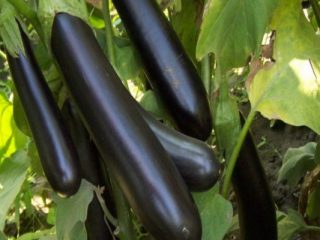Content
Thrips on eggplant seedlings appear in dry air conditions and too high temperatures. The main preventive measure is constant moisture, not only of the soil, but also of the air. You can also prevent pest infestations using inexpensive glue traps. Insecticides are most often used as a means of destruction. You can also use folk remedies and biological methods.
Why are thrips dangerous?
Thrips are insects that are found on different continents; more than 6 thousand species live in nature. Insects go through all stages of development from egg to adult. Adults have a dark color - brown, black, gray, with a body 0.5-3 mm long.
The pests are dangerous because they are very prolific: each female lays up to 70 eggs on the leaves of eggplant seedlings. The larvae are very voracious. They feed on plant juices, which is why seedlings quickly die.
Thrips are dangerous because they have wings and quickly fly from one plant to another, which can cause damage to several beds at once. In addition, they carry dangerous infections, which only aggravates the situation.
Insects are omnivores - they can be found on seedlings and adult eggplants, as well as on other agricultural crops. Thrips even live on indoor plants, such as begonias, violets or ficus.
Reasons for appearance
Thrips are common in different regions of the temperate climate zone, so their invasion cannot be completely excluded. The main causes are spread through contaminated soil, as well as from infected plants located nearby.
There are several factors that increase the likelihood of eggplant seedlings being damaged by thrips:
- low air humidity;
- dry soil;
- high temperature, drought;
- improper care (soil and containers were not disinfected).
Signs of defeat
Thrips are quite large, so upon close inspection the insects and traces of damage on eggplant leaves can be seen with the naked eye. The pests have a miniature body 1-3 mm long, although some specimens reach 14 mm. Color ranges from light brown to black and gray. The larvae are small, up to 1 mm. The color is light yellow, so they are less noticeable on seedlings.

Pests are most often located on the inside of the leaf blade
The main signs of the appearance of thrips on eggplants:
- small light yellow spots, streaks on the leaves;
- gradually they increase in size and merge;
- small dots on the tops of seedlings are traces of thrips vinegar;
- the foliage curls, withers and dies;
- sticky discharge on shoots.
As a rule, thrips colonies take over one bush and then move on to another. Moreover, the plant can quickly die because it loses nutrients.
How to get rid of thrips on eggplant seedlings
To combat Californian thrips on eggplants, different methods are used. One effective option is chemical treatment. You can also use folk remedies, set traps and apply biological methods.
Traps
To combat thrips on eggplant seedlings, blue and yellow glue traps are used. This is a universal remedy that affects all types of dangerous pests, including tobacco, flower and Californian (greenhouse) thrips.
The essence of the method is quite simple. Pests perceive a certain color as a bait, rush to the surface and stick to it, and then die. To effectively catch insects, one trap is installed for every 10 square meters.
Biological methods
Thrips have natural enemies. To get rid of insects on eggplant seedlings, purchase a colony of the predatory bug Orius laevigatus and release it into the growing area, including the greenhouse. The bug is very useful - it destroys aphids, spider mites and butterfly eggs.
Chemicals
Chemicals are the most powerful means of combating thrips on seedlings. They are bred strictly according to the instructions, and then processing begins. It is necessary to observe personal safety measures - use a mask, gloves and other protective equipment. After treatment, the room is ventilated to prevent the accumulation of harmful fumes.

Insecticides are used to kill thrips on seedlings.
Among the most effective means against pests on eggplant seedlings are the following:
- “Agravertine” is a biological composition that penetrates upon contact with insects. It acts quite quickly and is consumed quite economically - 5 ml per 500 ml of water.
- "Aktara" has a rapid effect due to the high rate of absorption by plants.
- "Actellik" is an insecticide against many insects, including thrips on eggplant seedlings. Refers to contact-intestinal agents. To prepare the liquid, you need to dissolve the contents of the ampoule in 1 liter of water.
- "Vertimek" is a drug with an enteric contact mechanism of action. Used to combat both insects and ticks. Showed itself well in closed ground conditions. Use 2.5 ml per 10 liter bucket of water.
- “Decis” is a contact-type insecticide that helps control thrips on eggplant seedlings. Destroys pests at all stages of development.
- "Inta-Vir" is a product with a universal spectrum of action. Used to destroy pests on seedlings, in open and closed ground. It is safe for people and animals. It is used sparingly - only 1 tablet per 2 liters.
- “Karate” is a contact insecticide, it helps to cope well with thrips on eggplant seedlings, it is consumed in the amount of 2 ml per 10 liters.
- “Karbofos” – 75 g per 10 l. It is moderately toxic, so precautions must be taken during processing.
- "Fitoverm" is a biological insecticide that destroys thrips and other pests of eggplant seedlings. Consumption – 10 ml per 1 liter of water.
- "Fufanon" is an insecticide based on organophosphorus compounds. Effective against most known insects.
Folk remedies
You can also treat eggplant seedlings against thrips using folk remedies. They are not as effective as chemicals, so they should be used in the early stages, as well as in combination with insecticides.

If the invasion is small, folk remedies will help cope with pests
Among the most effective recipes are the following:
- Garlic infusion. Take five cloves of garlic, chop, infuse in 1 liter of water, filter and begin processing the seedlings.
- Infusion of marigolds. Take 500 g of flowers, add 1 liter of water, leave for two days. Strain and spray the seedlings.
- Infusion of dandelion roots or leaves. Pour 50 g of plant material into 1 liter of warm water. Leave for 3 hours, filter and spray the eggplants.
- Chamomile infusion. Pour 100 g of dry raw material (can be bought at a pharmacy) with a liter of water and leave overnight. Strain and add a second liter of water.
- Take tomato leaves, chop them, get 50 g, add 1 liter of water and leave for several hours.
Preventive measures
Since it is quite difficult to control thrips on eggplant seedlings, it is necessary to take preventive measures to prevent an invasion. Experienced summer residents recommend the following methods:
- Monitor the humidity level in the room where the seedlings are growing. It is necessary to regularly humidify the air from a sprayer or a special device, since pests spread quickly in a dry environment.
- Inspect the seedlings regularly, especially the undersides of the leaves.
- Hang glue traps.
- If any plant is damaged, it must be immediately quarantined and, if necessary, destroyed.
- Disinfect the soil for seedlings, for example, pour it with a pink solution of potassium permanganate or keep it in the freezer for several days.
Conclusion
Thrips on eggplant seedlings spread from neighboring affected plants, as well as through contaminated soil. Provoking factors are dry air and high temperature. Insects are very dangerous, so their appearance and spread must be closely monitored. If necessary, treat with chemicals and folk remedies.








